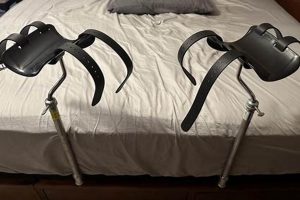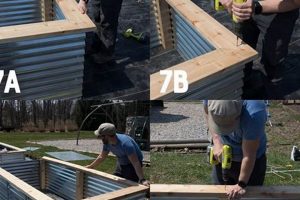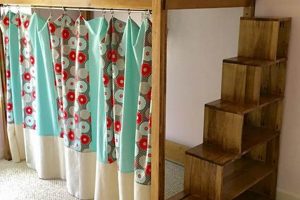A self-constructed shelter designed to fit within the cargo area of a pickup truck provides a mobile and customizable lodging solution. These structures range from basic shells offering protection from the elements to elaborate, fully-equipped living spaces. For instance, an individual might construct a simple wooden frame covered with canvas, or alternatively, build a more complex insulated structure with windows, a door, and integrated storage.
The construction of a customized mobile shelter presents a cost-effective alternative to purchasing a pre-made recreational vehicle, affording builders the opportunity to tailor the design to their specific needs and preferences. Its roots lie in the desire for accessible outdoor travel, evolving from rudimentary camping setups to increasingly sophisticated and personalized builds. The advantages include reduced travel expenses, access to remote locations, and the satisfaction of creating a unique, personalized travel experience.
The subsequent discussion will explore various aspects related to this type of vehicular accommodation, including design considerations, material selection, construction techniques, legal implications, and safety precautions, providing a framework for individuals considering undertaking such a project.
Essential Considerations for Self-Built Truck Bed Accommodations
The construction of a shelter within a pickup truck’s cargo area requires careful planning and execution. The following guidelines address critical aspects of the build process, promoting safety, functionality, and adherence to regulatory standards.
Tip 1: Prioritize Weight Management. The added mass of a self-built structure significantly impacts vehicle handling and fuel efficiency. Select lightweight materials and design with a focus on minimizing unnecessary weight. Exceeding the vehicle’s specified weight capacity poses safety risks and potential mechanical damage.
Tip 2: Ensure Secure Mounting. Proper attachment to the truck bed is paramount. Utilize robust fastening methods, such as bolted connections to the truck frame, to prevent shifting or detachment during transit. Regularly inspect these connections for wear or loosening.
Tip 3: Address Ventilation Requirements. Adequate airflow is crucial for preventing moisture buildup and ensuring occupant comfort. Incorporate vents or windows strategically placed to promote cross-ventilation, particularly when sleeping inside the enclosed space.
Tip 4: Plan for Electrical Systems. If incorporating electrical components, adhere to established safety codes. Use appropriately sized wiring, fuses, and circuit breakers to prevent electrical hazards. Consider the use of solar panels and battery systems for off-grid power solutions.
Tip 5: Implement Weatherproofing Measures. Thorough sealing of seams and joints is essential to protect against water intrusion and maintain a comfortable interior environment. Utilize durable, weather-resistant materials for exterior surfaces and roofing.
Tip 6: Optimize Interior Space. Maximize usable space through efficient layout and multi-functional furniture. Consider fold-down beds, integrated storage compartments, and modular designs to adapt to varying needs.
Tip 7: Verify Legal Compliance. Investigate local regulations regarding vehicle modifications and overnight parking. Ensure the constructed structure meets any relevant safety standards or inspection requirements.
Tip 8: Conduct Thorough Testing. Before embarking on extended travel, conduct trial runs to identify and address any potential issues. Test all systems, evaluate structural integrity, and refine the design based on real-world experiences.
Adhering to these guidelines enhances the safety, comfort, and longevity of the self-constructed truck bed accommodation. Diligence during the planning and construction phases contributes to a more enjoyable and reliable travel experience.
The next section will offer detailed guidance on specific building techniques and material choices.
1. Dimensions and Weight
The dimensional parameters and mass of a self-constructed truck bed accommodation are paramount considerations, directly influencing vehicle performance, safety, and regulatory compliance. Imprudent planning in these areas can lead to compromised structural integrity, reduced fuel efficiency, and potential legal ramifications.
- Exterior Dimensions and Vehicle Compatibility
External measurements must conform to the physical constraints of the truck bed and any applicable regulations concerning vehicle height and width. A design that exceeds these limitations may impede maneuverability, create hazardous driving conditions, and render the vehicle non-compliant with local traffic laws. An example is exceeding the maximum allowed height, which can restrict passage under bridges or in tunnels.
- Interior Dimensions and Usability
The internal space dictates the functionality and comfort of the living area. Balancing the need for adequate headroom, sleeping space, and storage capacity with the limitations of the truck bed dimensions requires careful design considerations. A poorly planned layout can result in a cramped and uncomfortable environment, negating the benefits of a mobile living space.
- Weight Distribution and Vehicle Stability
The distribution of mass within the structure significantly impacts vehicle stability and handling. Uneven weight distribution can lead to compromised braking performance, increased risk of rollovers, and accelerated wear on suspension components. Proper load balancing is essential to maintain safe driving characteristics, particularly in adverse weather conditions or on uneven terrain.
- Material Selection and Weight Minimization
The choice of construction materials directly affects the overall weight of the structure. Utilizing lightweight materials, such as aluminum framing and composite panels, can significantly reduce the load on the vehicle. Balancing the need for durability and weather resistance with the imperative of minimizing weight is a critical engineering challenge in self-built accommodations.
The interplay between these dimensional and weight-related factors is crucial for the successful implementation of a truck bed accommodation. A holistic approach, considering all these aspects in the design and construction phases, ensures a safe, functional, and legally compliant mobile living solution.
2. Material Selection
The selection of materials forms a foundational element in any self-constructed truck bed accommodation. Material choice directly impacts the structural integrity, weight, insulation properties, weather resistance, and overall longevity of the final product. The correlation is one of direct causation; a carefully considered selection results in a durable, safe, and functional living space, while a poorly informed choice can lead to structural failure, discomfort, and premature deterioration. For example, utilizing untreated lumber in a humid climate will invariably lead to rot and structural compromise, negating the benefits of any other design considerations.
The practical significance of understanding material properties lies in the ability to optimize the build for specific needs and environmental conditions. Individuals residing in colder climates might prioritize materials with high insulation values, such as closed-cell foam or fiberglass, to minimize heat loss. Conversely, those operating in warmer regions might focus on reflective materials and enhanced ventilation to mitigate solar heat gain. Material selection also affects the construction process itself. Working with lightweight materials, such as aluminum or composite panels, can simplify assembly and reduce the physical demands of the project, particularly for solo builders.
In summation, informed material selection is not merely a cosmetic consideration but a critical determinant of the success and sustainability of a self-built truck bed accommodation. Understanding the properties of available materials, and how these properties interact with the intended use and environment, is essential for creating a safe, comfortable, and durable mobile living space. The challenges lie in balancing cost, weight, durability, and ease of construction to achieve the desired outcome within the project’s constraints.
3. Securement Method
The method of securing a self-built truck bed accommodation to the vehicle chassis is a critical factor in ensuring safety and structural integrity. The connection between the camper and the truck frame dictates the resistance to forces generated during driving, including acceleration, braking, and lateral movement. Failure in this connection can lead to catastrophic detachment, resulting in property damage, personal injury, or even fatalities. Examples of inadequate securement include using only ratchet straps, which can loosen over time, or relying on the truck bed’s composite structure, which may not withstand significant stress. The practical significance lies in recognizing the securement method as a non-negotiable component that directly impacts the well-being of occupants and other road users.
Effective securement strategies often involve bolting the camper frame directly to the truck’s chassis at multiple points. This approach requires careful consideration of load distribution and stress points. For example, through-bolting with reinforced backing plates can distribute forces across a wider area, reducing the risk of localized stress fractures. Additionally, incorporating vibration dampening materials between the camper and the truck frame can mitigate the effects of road vibrations and prevent loosening of fasteners over time. Regular inspections of the securement points are essential to identify and address any signs of wear or fatigue.
In conclusion, the securement method is not a mere detail but a foundational safety element in the construction of a truck bed accommodation. Neglecting this aspect introduces significant risk, while prioritizing robust and well-engineered securement contributes to a safer and more reliable mobile living solution. The key challenge is balancing the need for strong securement with the desire for easy installation and removal, requiring a thoughtful and informed approach to design and implementation. Success hinges on recognizing that a strong connection is the link between a static box and a moving vehicle.
4. Weatherproofing
Weatherproofing represents a critical element in the design and construction of self-built truck bed accommodations, directly affecting occupant comfort, structural integrity, and the longevity of the dwelling. Inadequate weatherproofing exposes the structure to moisture intrusion, temperature extremes, and wind damage, potentially leading to material degradation, mold growth, and discomfort for occupants.
- Sealing of Seams and Joints
The effective sealing of all seams, joints, and penetrations is paramount to prevent water ingress. This necessitates the use of high-quality sealants, weather stripping, and flashing materials appropriate for the specific materials being joined. For example, using a marine-grade sealant around window and door installations ensures a watertight barrier against rain and snow. Failure to properly seal these areas can result in water damage, compromising structural components and creating an environment conducive to mold and mildew growth.
- Roofing and Water Runoff Management
The design and construction of the roof play a pivotal role in weatherproofing. A properly sloped roof, combined with effective gutter and downspout systems, facilitates water runoff and prevents ponding, which can lead to leaks. The choice of roofing material, whether metal, fiberglass, or a waterproof membrane, directly impacts the roof’s ability to withstand prolonged exposure to the elements. Insufficient slope or inadequate water management can result in water penetration and eventual structural damage.
- Insulation and Condensation Control
Effective insulation not only regulates temperature but also helps control condensation, a common issue in enclosed spaces. Insulation materials with a high R-value reduce heat transfer, minimizing temperature fluctuations and reducing the likelihood of condensation formation on interior surfaces. Proper ventilation, coupled with vapor barriers, further mitigates condensation and prevents moisture buildup within the walls and roof. Ignoring insulation and condensation control can lead to dampness, mold growth, and compromised air quality within the dwelling.
- Material Selection for Exterior Surfaces
The choice of materials for exterior surfaces is crucial for long-term weather resistance. Materials such as marine-grade plywood, aluminum composite panels, and treated lumber offer superior resistance to water damage, UV degradation, and insect infestation. Applying protective coatings, such as waterproof paints or sealants, further enhances the weather resistance of exterior surfaces. Selecting inappropriate materials or neglecting protective coatings can result in premature deterioration and necessitate costly repairs.
In summary, comprehensive weatherproofing is an indispensable element in the construction of a durable and comfortable self-built truck bed accommodation. Addressing each of these facets through careful material selection, meticulous construction techniques, and ongoing maintenance ensures a weatherproof environment that protects the structure and its occupants from the damaging effects of the elements. Failure to prioritize weatherproofing undermines the entire project, compromising safety, comfort, and the long-term viability of the dwelling.
5. Ventilation
Adequate ventilation constitutes a critical design element in self-constructed truck bed accommodations. The enclosed nature of these structures, combined with occupant respiration and potential moisture sources (cooking, condensation), creates an environment susceptible to elevated humidity, carbon dioxide buildup, and reduced oxygen levels. The consequences of insufficient ventilation range from discomfort and impaired sleep quality to more serious health concerns, such as respiratory distress or carbon monoxide poisoning if heating or cooking appliances are improperly vented. For example, a sealed camper operating in humid conditions can quickly develop condensation issues, leading to mold growth and compromising the structural integrity of the materials. The correlation between proper ventilation and occupant well-being is direct and quantifiable.
Effective ventilation strategies encompass both passive and active methods. Passive ventilation relies on strategically placed vents and windows to promote natural airflow. Considerations include vent placement relative to prevailing winds and the inclusion of insect screening. Active ventilation utilizes mechanical systems, such as fans, to force air circulation. These systems can be particularly beneficial in hot climates or when cooking inside the camper. The practical application involves carefully calculating the required airflow rate based on occupancy, activity levels, and environmental conditions, and selecting appropriate ventilation solutions to meet those needs. Furthermore, monitoring humidity levels and carbon dioxide concentrations provides data for optimizing ventilation strategies.
In summation, ventilation in a self-built truck bed accommodation is not a mere amenity but a necessity for ensuring occupant health and safety. The challenges lie in designing ventilation systems that are both effective and energy-efficient, while also minimizing noise and light intrusion. Addressing these challenges requires a thorough understanding of airflow dynamics, material properties, and occupant needs. Ultimately, prioritizing ventilation as a core design principle contributes to a more comfortable, healthy, and sustainable mobile living experience.
Frequently Asked Questions
The following section addresses common inquiries regarding the design, construction, and regulatory considerations associated with self-built truck bed campers. These responses aim to provide factual information and dispel potential misconceptions.
Question 1: Is a truck bed camper build legally considered a permanent vehicle modification?
The classification of a truck bed camper as a permanent vehicle modification varies by jurisdiction. In many areas, a camper that is easily removable and does not alter the vehicle’s original structure is not considered a permanent modification. However, local regulations should be consulted to ensure compliance.
Question 2: What is the average cost associated with constructing a truck bed camper?
The cost of a self-built truck bed camper varies significantly based on the materials used, the complexity of the design, and the inclusion of amenities. A basic, minimalist build can cost several hundred dollars, while a more elaborate and fully equipped camper can range into the thousands.
Question 3: How does the added weight of a truck bed camper impact fuel efficiency?
The additional weight of a camper negatively impacts fuel efficiency. The degree of impact depends on the weight of the camper and the vehicle’s engine and drivetrain. It is advisable to select lightweight materials and designs to minimize fuel consumption.
Question 4: What are the primary safety considerations during the construction phase?
Safety considerations during construction include wearing appropriate personal protective equipment, such as eye protection and gloves, and using power tools safely. Ensuring proper ventilation when working with adhesives, sealants, and coatings is also crucial. Furthermore, secure mounting and weight distribution are paramount for safe operation.
Question 5: How is condensation managed within a truck bed camper?
Condensation management involves adequate ventilation, insulation, and the use of moisture barriers. Proper ventilation allows moist air to escape, while insulation minimizes temperature differentials that contribute to condensation. Vapor barriers prevent moisture from migrating into wall cavities.
Question 6: What type of maintenance is required for a self-built truck bed camper?
Regular maintenance includes inspecting and resealing seams and joints, checking for leaks, and ensuring the securement system remains tight and undamaged. Additionally, maintaining any electrical or plumbing systems is essential for safe and reliable operation.
These answers offer a starting point for addressing key considerations associated with truck bed camper construction. Further research and planning are necessary to ensure a successful and safe build.
The subsequent section will detail specific design principles applicable to this type of project.
Conclusion
The preceding analysis has elucidated critical aspects of constructing a “diy truck bed camper”, encompassing design considerations, material selection, securement protocols, weatherproofing techniques, and ventilation strategies. Adherence to these principles directly influences the structural integrity, safety, and habitability of the resulting mobile dwelling. The information presented underscores the importance of meticulous planning and execution throughout the build process.
Prospective builders should approach this endeavor with diligence, prioritizing safety and regulatory compliance. Thorough research, careful material selection, and adherence to established construction techniques are paramount to realizing a functional and dependable “diy truck bed camper”. The potential rewards of a well-executed project include enhanced travel opportunities and a personalized mobile living space.







